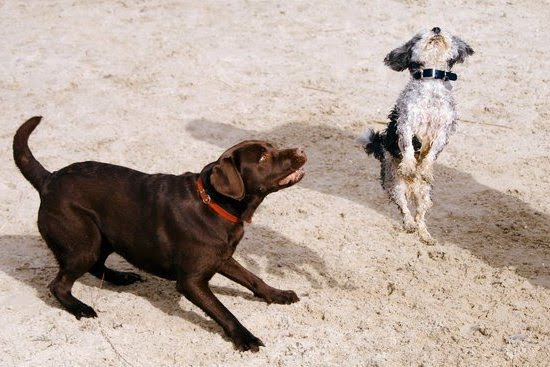Training a dog to behave off leash is an essential skill for both their safety and freedom. Having a dog that can confidently navigate the world without being tethered to a leash allows them to experience more physical exercise and mental stimulation. In this section, we will explore why off-leash training is crucial and the benefits of having a dog that behaves off leash.
Off-leash training is vital for a dog’s safety because it enables them to roam freely without getting tangled in their leash or getting into dangerous situations. When dogs are trained to behave off leash, they can explore their surroundings with more confidence and independence, which promotes their overall well-being. Additionally, off-leash training enhances the bond between you and your furry companion since both of you can enjoy activities together without the restriction of a leash.
Furthermore, having a dog that behaves off leash opens up a world of opportunities for you and your pet. You can take them on hikes, runs, or visits to the beach without worrying about keeping them on a tight rein. Training your dog to behave off leash also helps create more positive experiences during outdoor adventures since they have the freedom to engage in natural behaviors like chasing balls or playing with other dogs while still responding reliably.
In the following sections of this article, we will discuss how to assess if your dog is ready for off-leash training, how to build a strong obedience foundation, create safe training environments, increase distance and distractions gradually, teach recall effectively, develop focus and communication skills, reinforce reliable behaviors through proofing and positive reinforcement techniques. We will also cover safety measures like recommended equipment and precautions when exploring new outdoor areas with your off-leash trained dog.
So let’s dive in.
Assessing Readiness
Before embarking on off-leash training with your dog, it is crucial to evaluate their readiness and determine if they are prepared for this level of freedom. Assessing your dog’s obedience skills and behavior on leash will give you a good indication of whether they are ready for off-leash training or if there are any underlying challenges or behavior issues that need to be addressed first.
Evaluating your dog’s obedience skills
The first step in assessing your dog’s readiness is evaluating their obedience skills. Your dog should be able to reliably obey basic commands such as sit, stay, and come when called while on a leash. If they struggle with these commands even when on a leash, it may be an indication that they are not yet ready for off-leash training.
Identifying potential challenges or behavior issues
In addition to evaluating obedience skills, it is important to identify any potential challenges or behavior issues that may arise during off-leash training. Some dogs may have a high prey drive or a strong instinct to chase, which can make them more difficult to control when off leash. Others may struggle with impulse control or have fear-based behaviors that need to be addressed before allowing them off leash.
If your dog displays any aggression towards people or other animals, it is crucial to work on addressing these issues before attempting off-leash training. Aggression can pose serious safety risks in an off-leash setting and should be taken seriously.
By thoroughly assessing your dog’s current capabilities and addressing any existing challenges, you can ensure a smoother transition into off-leash training and set both you and your pup up for success. Remember, every dog is unique and may require different levels of preparation before being ready for off-leash adventures.
Building a Strong Foundation
Basic obedience training is an essential component of off-leash training for dogs. By teaching your dog foundational commands such as sit, stay, recall, and heel, you are laying the groundwork for successful off-leash behavior. This section will provide step-by-step instructions for training these commands effectively.
The Importance of Teaching Basic Commands
Before venturing into off-leash training, it is crucial to ensure that your dog understands and responds reliably to basic commands. These commands not only enhance your control over your dog but also establish a line of communication between you and your furry friend. Teaching these commands will help keep your dog safe and well-behaved in various situations.
Step-by-Step Training Instructions
- Sit: Begin by holding a treat close to your dog’s nose and slowly raise it above their head. As they follow the treat with their eyes and nose, their bottom will naturally lower into a sitting position. Once they are fully in a sit, praise them with the treat and verbal praise like “Good boy/girl.” Repeat this process several times until they understand the command.
- Stay: Start with your dog in a sitting or standing position. Hold out your open palm towards them like a stop sign while saying “Stay” firmly. Take one step back, maintaining eye contact with your dog. If they remain in place after a few seconds, return to them quickly and reward them with praise or treats. Gradually increase the distance and duration as they become more reliable at staying in place.
- Recall: Begin by practicing recall in a low-distraction environment indoors or in a securely enclosed space outdoors. With your dog on a leash initially, say their name followed by “Come” or “Here.” Gently tug on the leash while taking a few steps backward to encourage them to follow you.
When they reach you, reward them generously with treats and praise. Gradually increase the distance between you and your dog, always rewarding them for coming to you. - Heel: Start by having your dog walk beside you on a leash, slightly behind your left leg. Hold treats in your left hand and lure them into position while saying “Heel.” As they follow the treat, walk forward with confidence, encouraging them to stay close to your side. Reward them consistently for maintaining the correct position.
By following these step-by-step instructions and practicing regularly with patience and consistency, you can build a strong foundation of obedience training that will set the stage for successful off-leash behavior. Remember to always reward your dog for their efforts and progress, making the training process enjoyable for both of you.
Starting with a Secure Enclosed Space
When it comes to training your dog to behave off leash, starting in a secure enclosed space is crucial. This provides a safe environment for both you and your dog to focus on the training process without worrying about potential dangers or distractions. Here are some benefits of beginning off-leash training in a secure environment:
- Reduced Risk: By starting in a secure, fenced area, you can minimize the risk of your dog running away or getting into dangerous situations. This allows you to focus on teaching the necessary commands and behaviors without constantly worrying about your dog’s safety.
- Controlled Environment: A secure enclosed space provides more control over the training environment. You can control the level of distractions present, gradually introducing them as your dog progresses in their training. This controlled environment sets them up for success by gradually increasing their focus and obedience.
- Confidence Building: For dogs who are new to off-leash training, starting in a securely enclosed area helps build their confidence gradually. It gives them an opportunity to explore and learn while feeling safe and protected. As they master commands within this controlled environment, they become more comfortable and confident when transitioning to more open spaces.
To create an effective training environment, consider the following tips:
- Choose an area that is fully enclosed with sturdy fencing that your dog cannot escape from.
- Remove any potential hazards or distractions from the training space.
- Ensure that there is enough space for your dog to move comfortably during training sessions.
- Use positive reinforcement techniques such as treats or toys to motivate and reward your dog during training.
- Set aside regular time slots for off-leash training sessions in this enclosed area.
Remember, starting in a secure enclosed space sets the foundation for successful off-leash training. Once your dog has mastered basic obedience commands within this controlled environment, you can confidently move on to gradually increasing distance and introducing distractions.
Gradual Progression
Once your dog has mastered basic obedience training in a secure enclosed space, it’s time to start gradually increasing distance and introducing distractions. This step is crucial for preparing your dog to behave off leash in various environments.
Step 1: Increasing Distance
Start by taking small steps away from your dog while practicing commands such as sit, stay, and recall. Gradually increase the distance between you and your dog, making sure to reinforce the desired behavior with praise or treats. It’s important to go at a pace that is comfortable for both you and your dog, ensuring that they can still respond reliably to commands even at a greater distance.
Key Tips
- Use a long training leash initially to allow for greater distance without compromising control.
- If your dog struggles with longer distances, take a step back and practice at shorter distances until they are consistently responding.
- Vary the distance during training sessions to keep your dog engaged and challenge their understanding of commands.
Step 2: Introducing Distractions
As your dog becomes more proficient at following commands from a distance, it’s time to introduce distractions into the training environment. Start with mild distractions and gradually increase the level of difficulty over time. This could include other dogs, people walking by, or enticing smells like food.
Key Tips
- Prioritize safety during distraction training by ensuring that distractions are manageable and controlled.
- Use positive reinforcement techniques such as treats or praise when your dog successfully focuses on you despite the distractions.
- If your dog gets overly excited or distracted by certain stimuli, consider using desensitization exercises or counter-conditioning techniques.
Remember, the goal is to teach your dog to focus and obey commands even in distracting environments. By gradually increasing distance and introducing distractions, you are helping your dog build resilience and self-control. Be patient, consistent, and gradually challenge your dog’s abilities to ensure a well-behaved off-leash companion.
Recall Training
Recall training is one of the most crucial aspects of off-leash training for dogs. The ability to reliably call your dog back to you can prevent dangerous situations and provide peace of mind. In this section, we will explore effective strategies for teaching a reliable recall command, as well as address common challenges and provide troubleshooting tips.
To start with recall training, it is important to choose a word or phrase that your dog will associate with coming back to you. This word should be distinct and not easily confused with other commands. Once you have chosen your recall word, begin by practicing in a quiet and distraction-free environment.
Call your dog’s name followed by the recall word in an enthusiastic tone, such as “Buddy, come.” As soon as your dog starts heading towards you, praise and reward them with a treat or toy.
Consistency is key in recall training. Always reward your dog when they come to you when called, even if it takes them some time or they get distracted along the way. It is also important to gradually increase the difficulty level by practicing in different settings with varying levels of distractions. Start in a secure enclosed area before moving on to busier environments such as parks or streets.
One common challenge in recall training is when dogs become too focused on something else and ignore the recall command. If this happens, avoid chasing after your dog, as it can turn it into a game for them. Instead, try using high-value treats or toys as rewards that are more interesting than anything else around them. You can also practice recall during play sessions so that it becomes a positive experience for your dog.
Overall, recall training requires patience and consistency but is essential for keeping your dog safe while enjoying off-leash activities. By following these strategies and troubleshooting tips, you can help ensure that your furry friend reliably comes back whenever called.
| Recall Training Strategies | Troubleshooting Tips |
|---|---|
| Choose a distinct recall word or phrase | Avoid chasing after your dog if they ignore the command |
| Practice in distraction-free environments and gradually increase difficulty | Use high-value treats or toys as rewards to maintain interest |
| Praise and reward your dog when they come to you, even if it takes time | Incorporate recall training into play sessions for positive association |
Focus and Communication
Building a strong foundation of focus and communication is crucial when training a dog to behave off leash. This section will discuss techniques for improving your dog’s focus on you, even in distracting situations, as well as the importance of clear and consistent communication throughout the training process.
One effective technique for developing focus and connection with your dog is through reward-based training. By using positive reinforcement, such as treats or praise, you can reinforce desired behaviors and motivate your dog to pay attention to you.
When starting off-leash training, it is important to be proactive in rewarding your dog for checking in with you and maintaining eye contact. By doing so, you are strengthening the bond between you and your dog and teaching them that paying attention to you brings rewards.
Another technique for improving focus and communication is through interactive play sessions. Playing games like fetch or tug-of-war not only provide physical exercise but also serve as an opportunity for mental stimulation and bonding.
During these play sessions, incorporate commands such as “drop it” or “leave it” to reinforce obedience and responsiveness. Additionally, regularly engaging in interactive play helps establish a fun and positive association with being off leash, making the training process more enjoyable for both you and your furry friend.
Consistency in communication is also vital when training a dog to behave off leash. Use clear verbal cues or hand signals that are easy for your dog to understand. It is important to consistently use the same commands each time so that your dog can associate specific actions with specific cues.
For example, if you use the command “sit” to ask your dog to sit down on leash, use the same command when asking them to do so off leash. Additionally, body language plays a significant role in communication with dogs. Be aware of your posture and gestures, using confident and assertive body language that conveys leadership.
In summary, developing focus and communication skills are essential for successful off-leash training. Reward-based training, interactive play sessions, and consistent communication techniques all contribute to building a strong connection and trust between you and your dog. By investing time and effort in these areas, you can create a reliable off-leash companion who is attentive, responsive, and safe in various environments.
| Technique | Description |
|---|---|
| Reward-based Training | Using positive reinforcement to reward desired behaviors and motivate focus on the owner |
| Interactive Play Sessions | Incorporating obedience commands during playtime to reinforce focus and bond with the dog |
| Consistent Communication | Using clear verbal cues or hand signals consistently to ensure understanding of commands |
Proofing and Reinforcement
Once your dog has mastered the basics of off-leash training and is consistently demonstrating good behavior, it is time to focus on proofing and reinforcement. The goal in this stage is to make their off-leash behaviors reliable in a variety of real-life scenarios. By practicing in different environments and situations, you can ensure that your dog listens and obeys commands consistently, regardless of distractions or temptations.
To begin with, it is important to expose your dog to different environments gradually. Start by practicing off-leash behaviors in low-distraction areas such as a quiet park or an empty field. As your dog becomes more comfortable and reliable in these settings, gradually increase the difficulty level by introducing more distractions. This could include playing fetch near other dogs or having your dog walk past tempting food or toys without reacting.
During this stage, positive reinforcement remains essential for reinforcing good behavior. When your dog responds correctly to a command while off leash, reward them with praise, treats, or playtime. It is important to be consistent with rewards so that your dog understands what they are being rewarded for. Additionally, be sure to vary the rewards so that your dog remains motivated and engaged during training sessions.
Another aspect of proofing and reinforcement is practicing recall commands in various scenarios. This involves teaching your dog to come when called regardless of the distractions present. Start by practicing recall commands in controlled environments without any distractions and gradually progress to more challenging situations where there may be other dogs, people, or enticing smells.
Overall, proofing and reinforcement are crucial steps in ensuring that your dog’s off-leash behaviors are reliable and consistent. By gradually exposing them to different environments and distractions while rewarding their good behavior consistently, you can confidently trust that they will behave appropriately even when off leash. Through patience and practice, you can enjoy the freedom and joy that comes with having a well-behaved off-leash trained dog.
Safety Measures
When it comes to off-leash training, ensuring your dog’s safety should be a top priority. This section will discuss the essential equipment and precautions you need to take to keep your dog safe during off-leash activities.
One of the most important pieces of equipment for off-leash training is a reliable harness or collar. A well-fitted harness can provide better control over your dog while also minimizing the risk of injury, especially for dogs prone to pulling or lunging. Additionally, a sturdy leash is essential for situations where you may need to have temporary control over your dog, such as when encountering unfamiliar individuals or potentially dangerous environments.
In addition to the right equipment, there are other precautions you should consider before letting your dog roam freely off-leash. First and foremost, make sure that your dog has proper identification, including a collar with an identification tag. Microchipping is another recommended safety measure as it provides a permanent form of identification in case your dog becomes lost.
Before venturing into new outdoor areas with your off-leash trained dog, do thorough research about any potential hazards in those locations. Be aware of local regulations or leash laws that may apply, and respect them accordingly. Not all areas are suitable for off-leash activities due to risks such as busy roads, wildlife presence, or dangerous terrain.
Lastly, always supervise your off-leash trained dog and keep an eye out for any signs of distress or aggression towards other animals or people. Even the most well-behaved dogs can become overwhelmed in certain situations, so it is important to be mindful of their behavior and intervene if necessary.
By taking these safety measures and precautions into consideration, you can ensure that both you and your furry companion are able to enjoy the freedom of off-leash activities while minimizing potential risks or accidents. Remember that responsible ownership includes not only training your dog but also prioritizing their safety at all times.
Conclusion
In conclusion, off-leash training is not only important for a dog’s safety but also for their freedom. By investing time and effort into training your dog to behave off leash, you are providing them with the opportunity to explore and enjoy their surroundings without the constraints of a leash.
Assessing your dog’s readiness for off-leash training is crucial before beginning the process. Evaluate their obedience skills and behavior on leash to identify any potential challenges or behavior issues that need to be addressed beforehand. Building a strong foundation of basic obedience training is essential, teaching commands such as sit, stay, recall, and heel.
Starting in a secure enclosed space allows you to create a safe environment for both you and your dog during the initial phases of off-leash training. Gradually increasing distance and introducing distractions will help your dog learn to focus and obey commands even in distracting environments. Recall training is an integral part of ensuring your dog’s safety when off leash, so it is important to teach them a reliable recall command.
Throughout the entire training process, focus on developing a strong connection with your dog through clear and consistent communication. Positive reinforcement plays a significant role in making off-leash behaviors reliable, so be sure to reward your dog for their good behavior.
Finally, remember the importance of safety measures by using recommended equipment and taking necessary precautions when exploring new outdoor areas with your trained dog.
Frequently Asked Questions
How do I train my dog to come when called off the leash?
Training a dog to come when called off the leash starts with building a strong foundation of recall while on a leash. Start indoors or in a quiet, enclosed area where distractions are minimal. Use a long training leash and call your dog’s name followed by a command like “come” or “here.” Reward your dog with praise and treats whenever they come to you.
Gradually increase the distance between you and your dog, still using the long leash for control. As your dog becomes more reliable, gradually transition to off-leash training in secure areas, starting again with minimal distractions and gradually progressing to higher levels of distractions. Consistency, positive reinforcement, and patience are key in successfully training your dog to come when called off the leash.
How do you train a dog to stay close to you without leash?
Teaching a dog to stay close without a leash involves several steps. Begin by reinforcing basic obedience commands such as “stay,” “sit,” and “come.” Use these commands consistently during walks while on-leash until they become second nature to your dog. Once these commands are well-established, choose an area where there are limited distractions and let your dog off the leash while keeping them under close supervision.
Utilize verbal cues combined with hand signals to reinforce commands like “stay” and “come.” Reward your dog generously when they respond appropriately and stay close to you without wandering away. Gradually introduce more challenging environments as your dog becomes reliable at staying close without a leash.
What to do if a dog gets off leash and runs away?
If a dog gets off its leash and runs away, it is important not to panic but act calmly yet swiftly. Firstly, do not chase after the dog as they may see it as an invitation for play or get further scared causing them to run even faster. Instead, try calling their name in a calm but firm voice while encouraging them to come back using an excited tone of voice or high-value treats that may entice them back towards you. If possible, enlist help from others who can form a human barrier to prevent the dog from going further away or approach it from different directions.
It may also be helpful to have familiar items like their favorite toy or a blanket with your scent on hand. Additionally, reach out to local animal control or shelters to notify them that your dog is missing, and provide them with a detailed description of your dog and where it was last seen. Taking preventative measures such as ensuring your dog always wears proper identification tags and microchipping can also improve the chances of being reunited with your pet if they do get off leash and run away.

Welcome to the blog! I am a professional dog trainer and have been working with dogs for many years. In this blog, I will be discussing various topics related to dog training, including tips, tricks, and advice. I hope you find this information helpful and informative. Thanks for reading!





